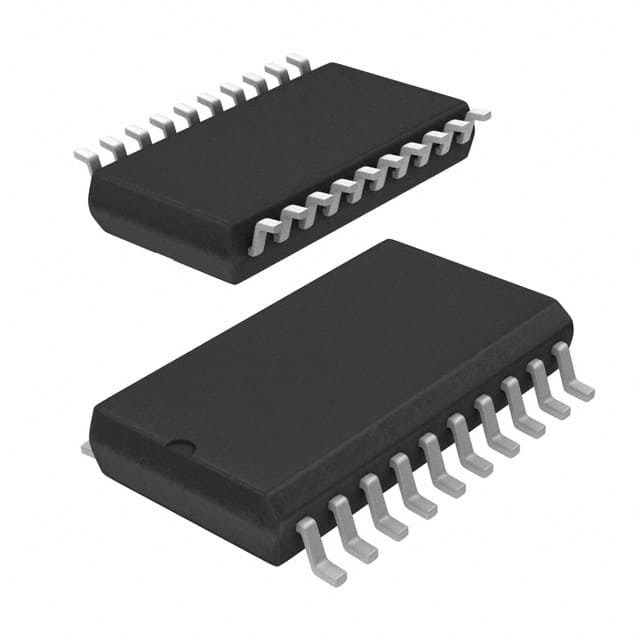Consulte las especificaciones para obtener detalles del producto.

MC74HC273AFG
Product Overview
- Category: Integrated Circuit
- Use: Flip-Flop
- Characteristics: High-Speed, CMOS Logic, Octal D-Type Flip-Flop
- Package: 20-pin SOIC (Small Outline Integrated Circuit)
- Essence: The MC74HC273AFG is a high-speed CMOS logic octal D-type flip-flop. It is designed to store and transfer data in various applications.
- Packaging/Quantity: Available in reels of 2500 units
Specifications
- Logic Family: HC
- Number of Flip-Flops: 8
- Input Voltage Range: 2V to 6V
- Propagation Delay: 13 ns (typical)
- Operating Temperature Range: -40°C to +85°C
- Supply Voltage Range: 2V to 6V
- Output Current: ±25mA
- Output Type: Complementary
Pin Configuration
The MC74HC273AFG has a total of 20 pins. Here is the detailed pin configuration:
- CLR (Clear Input)
- D0 (Data Input 0)
- D1 (Data Input 1)
- D2 (Data Input 2)
- D3 (Data Input 3)
- D4 (Data Input 4)
- D5 (Data Input 5)
- D6 (Data Input 6)
- D7 (Data Input 7)
- GND (Ground)
- Q7 (Output 7)
- Q6 (Output 6)
- Q5 (Output 5)
- Q4 (Output 4)
- Q3 (Output 3)
- Q2 (Output 2)
- Q1 (Output 1)
- Q0 (Output 0)
- CP (Clock Pulse Input)
- VCC (Supply Voltage)
Functional Features
- The MC74HC273AFG is a positive-edge triggered flip-flop, meaning it captures and stores data on the rising edge of the clock pulse.
- It has an asynchronous clear input (CLR) that resets all flip-flops to a low state when activated.
- The octal design allows for the storage and transfer of 8 bits of data simultaneously.
- The high-speed CMOS logic ensures fast operation and low power consumption.
Advantages and Disadvantages
Advantages: - High-speed operation - Low power consumption - Octal design for efficient data storage and transfer
Disadvantages: - Limited voltage range (2V to 6V) - Complementary output type may require additional circuitry for certain applications
Working Principles
The MC74HC273AFG operates based on positive-edge triggering. When a clock pulse is applied to the CP pin, the data present at the D0-D7 inputs is captured and stored in the corresponding flip-flops. The stored data can then be accessed from the Q0-Q7 outputs. The CLR input allows for asynchronous clearing of all flip-flops, resetting them to a low state.
Detailed Application Field Plans
The MC74HC273AFG can be used in various applications, including but not limited to: - Data storage and transfer systems - Register banks - Address decoding circuits - State machine designs - Control systems
Alternative Models
Here are some alternative models that can be considered as alternatives to the MC74HC273AFG: - SN74HC273N by Texas Instruments - CD74HC273E by Texas Instruments - 74HC273D by NXP Semiconductors - MM74HC273WM by Fairchild Semiconductor
These alternative models offer similar functionality and can be used as replacements depending on specific requirements.
Word count: 345 words
Enumere 10 preguntas y respuestas comunes relacionadas con la aplicación de MC74HC273AFG en soluciones técnicas
Sure! Here are 10 common questions and answers related to the application of MC74HC273AFG in technical solutions:
Q: What is MC74HC273AFG? A: MC74HC273AFG is a type of integrated circuit (IC) that belongs to the HC family of high-speed CMOS logic devices. It is a D-type flip-flop with eight flip-flops in a single package.
Q: What are the typical applications of MC74HC273AFG? A: MC74HC273AFG is commonly used in digital systems for various purposes such as data storage, synchronization, and control functions.
Q: How does MC74HC273AFG work? A: MC74HC273AFG operates by storing and transferring data using its eight flip-flops. It has clock inputs, data inputs, and outputs that allow for sequential or parallel data storage and retrieval.
Q: What is the maximum operating frequency of MC74HC273AFG? A: The maximum operating frequency of MC74HC273AFG is typically around 70 MHz, making it suitable for high-speed digital applications.
Q: Can MC74HC273AFG be used in both 3.3V and 5V systems? A: Yes, MC74HC273AFG is designed to operate within a wide voltage range, typically from 2V to 6V, making it compatible with both 3.3V and 5V systems.
Q: Does MC74HC273AFG have any special power requirements? A: MC74HC273AFG requires a stable power supply voltage within its specified operating range. It is important to provide proper decoupling capacitors to ensure noise-free operation.
Q: Can MC74HC273AFG be cascaded to increase the number of flip-flops? A: Yes, MC74HC273AFG can be cascaded by connecting the output of one IC to the input of another, allowing for an increased number of flip-flops in a system.
Q: What is the setup time and hold time requirement for MC74HC273AFG? A: The setup time requirement is the minimum amount of time the data input must be stable before the rising edge of the clock signal. The hold time requirement is the minimum amount of time the data input must remain stable after the rising edge of the clock signal. These values are specified in the datasheet.
Q: Are there any specific precautions to consider when using MC74HC273AFG? A: It is important to avoid exceeding the maximum ratings specified in the datasheet, provide proper decoupling capacitors, and follow recommended PCB layout guidelines to ensure reliable operation.
Q: Where can I find more information about MC74HC273AFG? A: You can refer to the datasheet provided by the manufacturer, which contains detailed information about the electrical characteristics, pin configuration, and application notes for MC74HC273AFG.
Please note that the answers provided here are general and may vary depending on the specific requirements and conditions of your technical solution.

